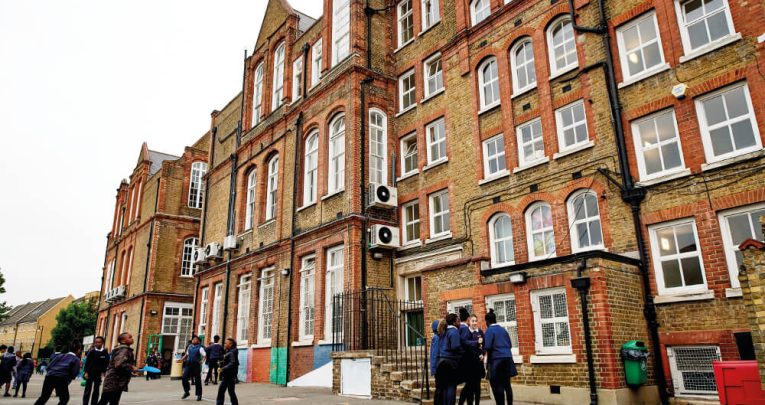Angel Oak Academy – Meet the school where 11 teachers are doing funded master’s degrees

“We don’t do fluffy – we do academic,” says headteacher Catherine Hewitt…

- by Elaine Bennett
- Digital content manager for Teachwire and former Teach Primary magazine editor

Angel Oak Academy is based in an imposing Victorian building, complete with a maze of staircases that don’t link to every floor – a relic from when boys and girls were taught separately in the school.
- Name
Angel Oak Academy - Executive headteacher
Tim Mills - Headteacher
Catherine Hewitt - Location
Peckham, London - Ofsted rating
Outstanding - Size
400+ - Extra info
Many pupils enter the school at an early stage of learning English
If a Victorian schoolmaster walked down the corridors today, he may not be completely surprised by what he saw.
The children sit in a uniform way, generally in rows, with backs straight and hands clasped on the table in front of them; lessons involve a lot of teacher talk and pupils are expected to be on the ball at all times or face a sanction; classroom displays are functional and minimalist.
There’s an air of businesslike efficiency throughout.
It hasn’t always been that way in recent times, however. Bordered on one side by the gritty North Peckham estate and on the other by eye-wateringly expensive apartments, the school used to have a notorious reputation – the young killers of Damilola Taylor attended in the nineties.
“It was a dangerous place,” says headteacher Catherine Hewitt of her first impression of the school when she looked round during her interview. She witnessed children shouting at teachers, chairs being thrown out of classrooms and a raft of supply teachers at the end of their tether.
“It was absolute chaos,” she continues. The local authority agreed, giving the school notice to close unless it academised. “Results were shockingly bad,” recalls Catherine. “I joined as a Y6 teacher in 2014 and had to teach my class the alphabet. These children, essentially, were being failed on every level.”
Arriving at the same time as current deputies Tom Garry and Alex Farley, and under the clear guidance and leadership of executive headteacher Tim Mills, the ambitious new team quickly realised that if any learning was going to take place, behaviour needed a complete overhaul.
“We very quickly put in what I’d describe as a moderately strict behaviour policy, although it felt very strict to the kids,” explains Catherine.
Deputy Alex Farley adds, “It really took a lot of effort to implement it. I remember going home at night in that first year and evaluating my role and whether it was actually worth it. Every day I felt drained, like I’d been in a physical fight. It was difficult and intense and there was no let-up.”
“We very quickly put in what I’d describe as a moderately strict behaviour policy, although it felt very strict to the kids”
For Catherine, a hard-line approach was the only option.
“These children were leaving school not knowing anything. We had to do something quickly so we could teach them. We’re a school – that’s our job. Some schools say their vision for their pupils is for them to be happy and confident. Ours is for them to be well-educated. That’s a solid foundation for them to build on and will lead to them being confident young people.
“That was our focus from day one. We received excellent support from senior leaders in our trust – STEP – and were given the freedom to innovate and make brave decisions around pedagogy and curriculum. We couldn’t have made the changes we needed to without this encouragement and guidance.”
1 | Three-teacher model
The community around Angel Oak Academy is very transient. Some pupils are from first-generation immigrant families who are not in the country legally, meaning their parents have no recourse to public funds.
“These are probably some of the most deprived children in the country,” says Catherine.
“Their parents are trying to hold things together as well as they can – and they do brilliantly – but it’s a very difficult lifestyle for many of them and they’re constantly moving around. None of our pupils are privileged; that’s not what we have here.”
For this reason, the school does not target its pupil premium funding at specific groups of children. “We couldn’t possibly start to divide them,” says Catherine, “because it just wouldn’t be fair.”
The school uses the majority of its pupil premium funding to run a three teacher model throughout the school. Each two-form entry year group is assigned three teachers. In the morning, children are split into three groups of 20 for phonics, reading, English and maths.
“We couldn’t possibly start to divide them because it just wouldn’t be fair”
In the afternoon, they are split into two larger groups. Three afternoons a week, one teacher takes children who have not fully grasped the morning’s content for 20 minute interventions. “These sessions are made up of some pupil premium and some non-pupil premium children,” explains Alex.
“Every child is expected to keep up with their learning and this model allows us to make sure every pupil is at the same point and ready to begin the next step.”
The teacher leading these afternoon sessions is, as much as possible, the most experienced, as Catherine explains:
“We’ve all worked at schools where the children who struggle the most are the ones who go out with the least qualified member of staff. That isn’t good enough for these kids which is why the most experienced member of staff runs these interventions.
“We don’t leave anyone behind. Early on, we don’t rush pupils through the curriculum, desperate to label them ‘greater depth’. Instead, we ensure solid foundations in learning for all children. The aim is that they all receive the learning they’re entitled to.”
Deputy headteacher Tom Garry adds, “We prioritise maths and English because we have to. In the curriculum they are given more importance and for good reason, we think. We really need our children to be literate and numerate above everything else.”
2 | Knowledge curriculum
As school standards minister Nick Gibb noted in a speech last year, there has been a noticeable push in curriculum planning “towards knowledge and away from skills” in some schools over the last few years. It’s an approach that the team at Angel Oak is fully committed to, as Catherine explains.
“The teacher holds the knowledge and the children need to know those things. They’re not going to just discover that knowledge magically by themselves.”
To this end, the school doesn’t dictate what proportion of lessons should be made up of teacher talk versus pupil-led activities.
“Teachers can speak for as long as they like and the children are expected to listen,” says Catherine.
“It’s quite didactic. There are times when the children work together, where it’s appropriate, but we don’t try to force it. Lots of activities aren’t collaborative – writing, for example, is a solitary endeavour. We’re not facilitators, we are teachers. That’s very important to us.”
To ensure that the learning sticks, children at Angel Oak are regularly quizzed. Catherine says, “We think it helps children transfer the knowledge into their long-term memories. If that doesn’t happen, what’s the point in anything?”
Tom adds, “In his book Memorable Teaching, Peps Mccrea says that you have to start with the assumption that children will forget what you teach them unless you take deliberate steps to make them remember, so that’s what we try and do.”
Pupils begin lessons with a ‘quadrant’ activity which encourages them to recall learning from this week, last week, a fortnight ago and a month ago.
Trending
3 | Evidence based
Catherine uses her CPD budget to fully fund master’s courses for teachers who want to do them. Currently, 11 members of staff are undertaking one.
“Quite a lot of the courses are based on effective practice in teaching,” explains Catherine. “All those ideas are fed back into a melting pot for everyone to consider. We send out a regular digest to staff which summarises the research we’ve been reading as an SLT.
“We look to employ very bright and able people who will engage in research and want to improve their practice. When new ideas arise, we run with them, trialling them in certain classes to see how it goes.”
In the first few years, SLT very much led the school’s strategy because, as Catherine puts it, “Teachers just needed some structure and direction for teaching, where previously they had been mainly managing behaviour” but now that behaviour has improved dramatically, teachers have more capacity to develop their own practice.
“Ultimately, everything we try has to fit in with our approach in terms of whether it is going to build knowledge for our children and give them personal and cultural capital,” says Catherine. “We always consider what the return on learning will be.”
A new initiative the school is trialling this year is knowledge organisers – A4 sheets of paper handed out to the children when they start a new class text, listing all the facts they need to be able to understand it fully (view some examples at angeloakacademy.org/curriculum-2).
“We got off to a little bit of a false start with them,” explains Tom.
“As an SLT we were really clear on why we were using them, but we perhaps didn’t communicate that as well as we might have to the teachers, so at first they saw them as an addition to their workload and didn’t really understand what they were going to be using them for.
“We had to come back to why we were doing it and make sure everyone was really clear.”
Catherine admits that it can be tempting to try too many new initiatives at once, especially when research is clear that there is a better way.
“We’ve perhaps been a bit gung-ho about some things,” she says. “We’re aware that we’re a young leadership team and we’re still all learning about how to effect change positively and bring our staff along with us.”
4 | Cultural capital
The curriculum at Angel Oak is aligned to a number of key books that staff believe pupils should experience before they leave primary. “We want them to access texts that all children should experience as part of a well-rounded education and those we feel are culturally important,” explains Catherine.
Titles and authors studied include Alice in Wonderland, Macbeth, Wind in the Willows, Stig of the Dump, Chaucer, Hans Christian Andersen and Anne Frank.
“We don’t do a loose topic like the Romans,” continues Catherine.
“If we’re doing the Iliad and the Odyssey, the children will learn about Greek myths and Ancient Greece. When we’re planning their learning, we ask ourselves what they need to know in order to understand the text, and we stick closely to that.
“In the past when I taught Ancient Greece or the Romans, what could the kids really tell me at the end? Probably something about Zeus or making a shield. We want them to have better knowledge than that.”
“We don’t do a loose topic like the Romans”
Not every book selection has been spot-on, admits Catherine. “They may have been culturally important, rich in language and well written, but the actual context behind them perhaps wasn’t so great. In that case, that’s a title that we might read to the children or use as a supplementary text, but we won’t study it.”
It’s Catherine’s ultimate aim to build up her pupils’ personal capital. “They should be able to look you in the eye and shake your hand,” she says. In fact, it’s a rule at the school that pupils must greet senior teachers when passing them in the corridor.
“They can’t arrive in a sulk or like Kevin the teenager,” continues Catherine. “When they’re out on the estate they might keep their hood up and their eyes down, but in other environments they need to know how to look confident, so we train them in that.
“They need to be able to write and read well and know a lot about the world, so they can stand shoulder to shoulder with anyone from any background. They won’t all go to university or be academics, but they should have that opportunity and that choice.
“There’s a lot of reasons why some of the children here might struggle and we understand that, but our expectation is the same for all our pupils, and they know that. That’s our approach – if you like it, come and join us. If you don’t, go and teach somewhere else.
“I’m not saying it’s the only way or even the best way, but it’s the best way for us. We don’t do fluffy, we do academic – and it seems to work for our children.”
Whole-class reading
Angel Oak Academy has scrapped guided reading in favour of a whole-class approach. “Reading at home isn’t a given for all of our children so we want them to have eyes on text for as long as possible in class,” explains Catherine.
“When I used to observe guided reading, I could see that that group isn’t reading, her book is upside down, he’s flicking paper at someone. How much reading was actually happening?”
The school has used the book Reading Reconsidered by Doug Lemov as its bible. One of the ideas the book champions is ‘reading mileage’. “Privileged children often get loads of reading miles,” says Catherine.
“Their parents have time to read to them and they have loads of books in their homes. Many of our children have a huge vocabulary deficit, so when we do science, they read about it first. When they do art, they might read about an artist. We keep the reading going throughout the day, rather than just a 20 minute carousel in the morning.”
Teachers lead choral reading every day, following Lemov’s ‘Control the game’ approach. “It’s basically round robin reading,” explains Catherine.
“When they’re not reading, they’ve got to follow along with their finger. They never know who’s going to be asked to read next so they have to be ready. If they’re not, they’ll get a warning, although the teacher will of course mitigate for children that might struggle.”
She continues, “We spend a lot of time on ‘close reading’, rather than constantly revisiting the same comprehension skills. This helps the children learn about authorial intention in many different contexts.”
Pupil voice
Konadu The best thing about this school is the teachers. They’re really down to earth and it’s like you’re talking to someone your own age. They really understand you and the lessons have changed a lot over time.
Fahridat When we became Angel Oak it was a big change. I used to feel annoyed about having to work so hard but now I’m becoming more and more intelligent. We are about to start Animal Farm – some people do that at GCSE.
Augustine We shake the headteacher’s and deputy headteachers’ hands as a sign of respect. I agree with it. What I really like about this school is how clever our teachers are. We learn subjects that other children our age haven’t learnt.







